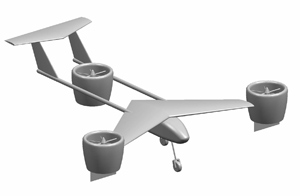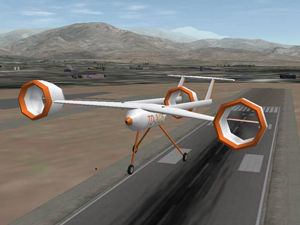 A next-generation unmanned aerial vehicle (UAV) possessing vertical takeoff and landing (VTOL) capabilities is undergoing development at the University of Missouri – Rolla. The conceptual design for this tilt-duct “VTOL UAV” – which features forward-swept wings and three tilting ducted propellers for propulsion – has been developed by Peter Cross, a Missouri Space Grant Consortium Graduate Fellow, as part of his Mater’s degree research in Aerospace Engineering at UMR. This tilt-duct UAV conceptual design has been the subject of in-depth analysis, particularly in the area of stability and control, and has undergone a “virtual” flight test program involving a flight simulation model of the aircraft. A next-generation unmanned aerial vehicle (UAV) possessing vertical takeoff and landing (VTOL) capabilities is undergoing development at the University of Missouri – Rolla. The conceptual design for this tilt-duct “VTOL UAV” – which features forward-swept wings and three tilting ducted propellers for propulsion – has been developed by Peter Cross, a Missouri Space Grant Consortium Graduate Fellow, as part of his Mater’s degree research in Aerospace Engineering at UMR. This tilt-duct UAV conceptual design has been the subject of in-depth analysis, particularly in the area of stability and control, and has undergone a “virtual” flight test program involving a flight simulation model of the aircraft.
VTOL UAVs provide a number of capabilities lacking with ordinary UAVs that implement more conventional aircraft configurations. Because of their VTOL capabilities (the ability to takeoff and land vertically as well as to hover in place), VTOL UAVs are especially suited for operations from ships, oil platforms, or similarly tight places, and are useful for a number of military and civilian missions, including: surveillance, reconnaissance, border patrol, search and rescue, off-shore oil platform servicing, power line and pipeline inspection, and more.
The triple tilt-duct configuration was selected for study because it had not yet been considered for application in a UAV design, and because it appeared to offer a number of desirable characteristics lacking in other VTOL aircraft configurations. These benefits included enhanced propeller thrust output, reduced noise output, physical shielding of the propeller, increased effective aspect ratio, and higher cruise speeds when compared to other VTOL aircraft designs. The triple tilt-duct configuration featured three identical pivoting ducted propeller units, one mounted on each wingtip and one located at the tail of the aircraft. Vertical flight was accomplished by orienting the ducted propeller units vertically, while in normal, horizontal flight the ducted propellers were directed forward horizontally.
The ducted propeller propulsion system offers enhanced thrust output for a given power input, and the endplate effect created by the wingtip-mounted ducted propellers can reduce the induced drag experienced by the aircraft. The duct surrounding the propeller also decreases the noise output from the propeller. In addition to this, the propeller duct serves as a safety device that prevents the propeller blades from striking objects or personnel.
When in vertical flight mode, thrust from the three identical ducted propellers acts like a tripod to support the aircraft. Because the aircraft is supported by thrust from three ducted propeller units, which support the aircraft much like the legs of a tripod, the precise location of the aircraft center of gravity is not as critical as it is with other VTOL aircraft designs, and good control can be obtain through the use of differential thrust. When in horizontal flight mode, the tilt-duct aircraft is operated and controlled in the same manner as a conventional airplane. Also, when flying horizontally, the tilt-duct aircraft design enjoys the naturally occurring dynamically stable behavior and handling characteristics associated with the traditional airplane configuration.
Finally, with the tilt-duct configuration it is still possible to perform conventional takeoff maneuvers at aircraft gross weights that prevent vertical flight. When performing these “overweight” takeoffs, it is possible to use thrust vectoring to reduce the takeoff ground roll significantly compared to the takeoff ground roll required by conventional aircraft.  The triple tilt-duct aircraft configuration possesses many desirable characteristics and performance capabilities. However, challenges remain to be solved before the tilt-duct aircraft configuration can reach maturity and widespread implementation. Yet with the enormous focus within the aerospace industry on unmanned aerial vehicles and the increasing interest and need for vertical takeoff and landing capabilities, it is likely only a matter of time before tilt-duct UAVs take their place in the skies. ~Peter Cross, MST
The triple tilt-duct aircraft configuration possesses many desirable characteristics and performance capabilities. However, challenges remain to be solved before the tilt-duct aircraft configuration can reach maturity and widespread implementation. Yet with the enormous focus within the aerospace industry on unmanned aerial vehicles and the increasing interest and need for vertical takeoff and landing capabilities, it is likely only a matter of time before tilt-duct UAVs take their place in the skies. ~Peter Cross, MST
|







